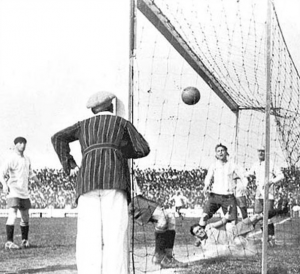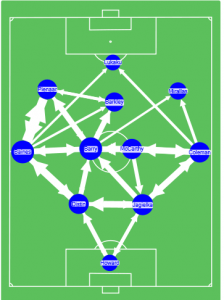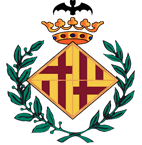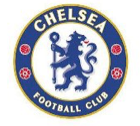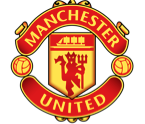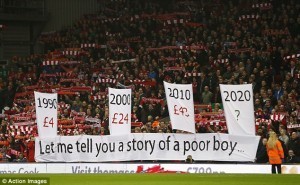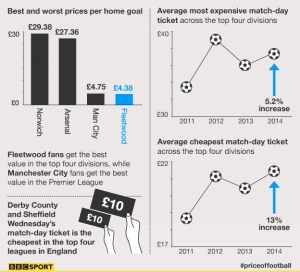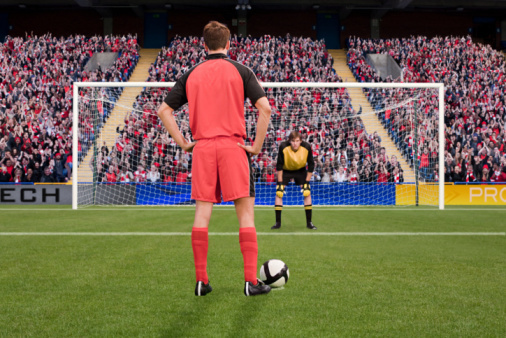Laurent Dubois's Blog, page 77
February 12, 2015
Defying the Laws of Physics: Gol Olímpico and Roberto Carlos
This past weekend, the US Men’s National Team took on Panama in an international friendly. As my friends and I were watching the game, the goal by Michael Bradley in the 27th minute immediately took over the room. At first glance, everyone, even some players on the field, was perplexed. We had thought that either the goalkeeper or Jozy Altidore had deflected it in, but upon further review we realized that Bradley had put it in straight off of the corner kick. This realization was baffling. We could not stop repeating the play for minutes, and continued talking about it for nearly a half hour. I had never seen a “Gol Olímpico” live. All of the discussion got me interested in researching the phenomena a little more, so I took out my computer and began surfing the net.
For the next hour or so I found myself reading articles and watching videos of goals like Bradley’s. I was truly in awe. Galeano states in Soccer in Sun and Shadow that Cesáreo Onzari was “the first in soccer history to score a goal that way,” after he did it in a friendly match between Argentina and Uruguay on October 2nd, 1924. However, according to various sources Onzari was not, in fact, the first player to do so. The goal was made legal by the International Football Assocation Board on June 15th, 1924, and Billy Alston of Scotland was actually the first player to make it a reality two months later on August 21st. However, it was Onzari’s strike that was dubbed with the name “Gol Olímpico,” because the opposing team (Uruguay) had just won the gold medal at the 1924 Olympics. After the game, Onzari himself admitted that he was in astonishment when he saw the ball in the back of the net. In an interview, Onzari once said, “Maybe the keeper got out of the wrong side of the bed that day or there were players blocking his path, because I never scored a goal like that again.”
As I continued researching, I came across a few facts that particularly grabbed my attention. To begin, Juan Alvarez of Colombia scored eight Olympic goals out of his 35 total goals in six seasons. In fact, he even did it twice in one game against Cúcuta Deportivo in 1976! Former German footballer Bernd Nickel once scored an Olympic Goal from the left corner with the outside of his left foot. This feat was repeated by a few players after him as well, most notably Roberto Carlos who is known for his superb goals that defied the laws of physics. The first Olympic Goal to actually take place in the Olympics was in 2012 when Megan Rapinoe scored for the US Women’s National Team against Canada in the semi-final match that they would go on to win.
When I was coming to the end of my research, I came across a video titled “Roberto Carlos Impossible Soccer Goal Explained.” Although this video was not the same as the Gol Olímpico, it was just as if not more eye-opening. As Carlos ran down the left side of the field at full speed, he proceeded to volley a bouncing ball across his body into the upper right corner of the net. Some people claim that this goal is the most improbable goal ever to be scored for a variety of reasons. Firstly, Carlos shot the ball from an angle of less than one degree in front of the net! On top of this, the goalie was in position and simply needed to lift one of his arms in order to mathematically eliminate the goal. To top it off, Carlos had to kick the ball at a ridiculously high speed in order for it to get by the keeper, and he did so. The ball travelled 29 meters in 0.93 seconds at a speed of 112.26 km/h, or roughly 70 miles per hour!
Bradley’s goal on Sunday, like all of the other Goles Olímpicos, was jaw-dropping. Over 90 years has gone by since Alston and Onzari shocked the world, and yet the goal still amazes all who witness it.
Dick,Kerr Ladies: Lily Parr y La Cuestión de Ligas Mezclas
En nuestra discusión de In a League of Their Own! The Dick, Kerr Ladies, discutimos la fuerza de la jugadora Lily Parr. Como la primera mujer en el “English Football Hall of Fame” y unas de las mejores jugadoras en el deporte de fútbol, ella tenía un montón de éxito. Me impresionó que ella presentara al público su homosexualidad, a pesar del rechazo social y la estigma sobre la homosexualidad que existía en su tiempo. En un tiempo que hemos visto en el cuento de los Dick, Kerr Ladies, donde habían muchos sufrimientos y desafíos por las jugadoras en fútbol, ella arriesgó la desaprobación pública por su sexualidad también. Muchos actores en la sociedad en el Reino Unido ya decían que el fútbol no era apropiado para las mujeres porque “hacen cosas malas a los cuerpos de mujeres”. En realidad, las razones subyacentes eran la amenaza del fútbol femenino al masculino y la inferioridad de mujeres en general en sociedad, con su papel típico ya en el hogar como las amas de casa.
Lily Parr rompió todo de estos estereotipos de mujeres como jugadores inferiores. Se decía que su juego fuera tan famoso por su disparo que era más fuerte que lo de hombres. En el libro, Gail Newsham relata una historia donde Lily demuestra sus habilidades en contra de un arquero quien se había burlado de ella como una jugadora. A cambio, ella marcó un gol cuando él estaba en gol. La gente decía que, como he dicho, mejor que muchos jugadores en este tiempo.
Esto estimuló una discusión sobre la carente de ligas mezclas actualmente, y porque la existe. Creo que porque todavía, y por siempre, va a existe el argumento de las diferencias biológicas que resultan en la inferioridad físicamente de las mujeres en deportes. La verdad es que las mejores mujeres no pueden correr con tanta velocidad, saltar tan alto, o levantar tantos pesos como los mejores hombres (en general) en los deportes. A pesar de esto, un compañero describió las diferencias también en todos los juegos entre mujeres y hombres en deportes diferentes. Si las reglas no son diferentes (y en algunos casos sí son), el estilo de los juegos es muy distinto.
Mujeres juegan con más inteligencia en algunos deportes, pero hombres con más fuerza en otros. En conclusión, decidí que si hay deportes que serán co-ed, los deportes individualistas, como tenis, van a comenzar primero. Esto, más que muestra el progresivo del deportes (porque no pienso que es una pregunta de esto) demuestra que las diferencias en capacidades físicas de un hombre y una mujer aparece menos cuando es 1 vs. 1. Cuando hay un equipo de mujeres, y un de hombres, las limitaciones biológicas van a aparecer mucho más en el juego.
The Martinez Way – Still Promising, Despite Recent Slump
Let’s talk statistics and tactics – or rather, let’s not. This is just a fan’s viewpoint of the strengths and drawbacks of Everton’s style of play, courtesy of their current manager, Roberto Martinez. I’ve been watching Martinez from his days as a manager of Wigan Athletic, and the style of play he demands, and the type of players he likes doing the job, seems to have remained generally consistent and solid since his final couple of seasons in Wigan.
- Rotatory front three, with two dribblers on the side
Martinez likes dribblers in the two side of front three; types of players that could make spaces on their own by beating their marksman with pace and trickery. In his Wigan days, it was the likes of Jordi Gomez, Victor Moses, or even Callum McManaman in season 12-13, his final season as Wigan manager; that is virtually identical to his front-three strategy in Everton. Players like Kevin Mirallas, Steven Pineaar, Aiden McGeady, and Romelu Lukaku (yes, I don’t see him as a front man) are natural dribblers, preferring to play with the ball and cutting inside from wider positions. The other front man serves as a pivot point from which the two dribblers can revolve around. Steven Naismith has been playing this integral part of Everton lately, switching positions with the front two and dropping into spaces created by them. However, Naismith’s style of play is different from his Wigan season 12-13 counterpart, Arouna Kone, whose tendency to stay up front and hustle with the opponent defenders brings a different effect to Martinez’s game. It is therefore, no surprise that Martinez brought Kone to Everton after his managerial switch, in order to bring another layer of depth into his core tactics – it’s just an unfortunate run of injuries that have kept Kone from delivering such effect.
Everton’s Passing Network in Season 13-14
Image by: Statsbomb.com
- Full-backs? No – More Like Wingers
The type of “full backs” Martinez has been deploying in both his Wigan and Everton days share a common trait; they’ve all had experiences as wingers. And the effect shows in Everton’s recent games. The likes of Leighton Baines, Seamus Colman, and Brian Oviedo all have tendency to push up the field, and all of them also have noticeable dribbling and even finishing skills, something that are not necessarily prominent among full backs. No, they are not fullbacks. They are borderline wingers with a defensive edge, joining in the front three in attacking the opponents and suffocating spaces out of them. Here is the main strength of Everton under Martinez; they have one of the greatest attacking threats in the Premier League teams, with good dribblers and crossers to make an ample amount of goal-scoring opportunities.
And yet, here also lies their main weakness. Because of the attacking nature of the full backs, the defensive responsibilities lie heavily on the two midfield players and the two central defenders. In his Wigan days, Martinez anticipated this weakness by deploying three central defenders in certain matches; in Everton, such approach has not yet been shown, for reasons I don’t know. As such, Everton had more chances allowed with Martinez as a manager than they had been under David Moyes’ management. The fact that the first-choice players in these defensive roles – Sylvain Distin, Phil Jagielka, Gareth Barry, James McCarthy, and even Tim Howard – are all in early-to-mid-30’s except for McCarthy has been an extremely concerning point for me, for I feel their relatively lack of pace and durability due to their age has been a factor of Everton’s recent slump and their tendency to concede late goals in matches.
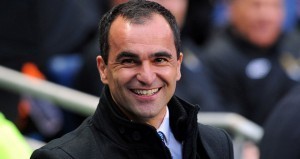
Roberto Martinez
Image from: Celebhealthy.com
Thankfully, Martinez has been working on the drawbacks of his tactics. His attempts to inject new blood into the aging defensive positions through the likes of Muhamed Besic, John Stones, and Joel Robles are positive signs that he is aware of the shortcomings of his squad, and he will surely look to bring in other young players in his squad as well, to undergo a period of transition that seems to become increasingly necessary for the club.
Overall, it is down to mixed fortunes and a period of transition that factored into Everton’s recent slump, rather than the manager himself. I am not worried about the claims that Martinez has run out of ideas to push the club forward; if given enough time and resources for him to perfect his playing ways, he will undoubtedly drive Everton to bigger and better times.
“MNF – Roberto Martinez’s Genius”
https://www.youtube.com/watch?v=O4WWT...
“EPL 2014-2015 Season Preview – Everton FC”
http://statsbomb.com/2014/08/epl-2014...
Featured Image From:
February 11, 2015
Egypt: Football fans involved in violence and political turmoil
On the 8th of February 2015, a clash erupted between police and football fans outside of the military-owned Air Defense Stadium in Cairo, Egypt. Estimates of how many were killed range from 19 to 40, but most sources estimate 22 deaths, with numerous more injured.
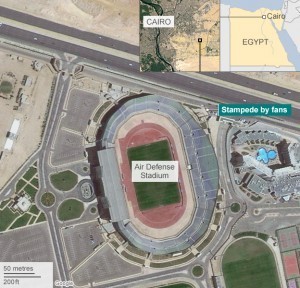
BBC- Cairo Stadium
There are varying accounts as to what happened and the cause of the events. Al Jazeera reported that supporters of the Zamalek football club tried to force their way into the stadium, creating a stampede. Police then reportedly used tear gas on the crowding fans, and violent struggles began. CNN reports a similar story, noting that the fans stampeding the stadium were ones without tickets attempting to get into the game. BBC includes a slightly different side of the story- Zamalek fans accuse the police around the stadium of forcing them through a fenced-in, narrow passageway entrance, creating a stampede.
The Egyptian football league has been indefinitely suspended while the investigation of this event occurs.
Yet, this already complicated issue is actually much more complex under the surface. Historical context reveals a slew of underlying tensions adding to the conflict.
Let’s go back to the Port Said stadium riot, on the 1st of February 2012, in which 72 people were killed due to fighting between fans. Al Jazeera reports that the fans groups Al-Masry and Al-Ahly, each belonging to an Egyptian football club, clashed at Port Said stadium, resulting in bloodshed and deaths. Football in Egypt was then indefinitely suspended, starting up again a year after the event. Yet, ever since the tragic event, the amount of fans allowed to attend matches has been seriously curbed. In fact, fans weren’t even allowed to attend matches until December of 2014, just weeks before the recent violence in Cairo, where very limited tickets were sold and few people let in (BBC reports that only 5,000 tickets were sold for the recent match in Air Defense Stadium, which can actually hold up to 30,000 spectators).
But there’s more. Al Jazeera also reports that it was the Al-Masry fans that attacked the Al-Ahly fans- with explosives, knives, and broken glass. And it gets weirder. Two police officers were sentenced to 15 years in jail for ‘gross negligence’ in relation to the riots. BBC reports that police supposedly failed to intervene in the bloody conflict. 7 other officers were on trial for the same conflict and charge, but were released without any jail time.
Why would police ever let a bloody fan riot continue without intervention? To answer this, we have to go even further back, to the 2011 revolution that ousted Hosni Mubarak and ended his rule. Egyptian football club superfans, also known as ‘ultras’, became politically active, united and took to the streets. The Ultras emerged in 2007, not associated with any political party in particular, but rather with the specific club they supported. The two main fan groups were the ‘Ultras Ahlawy’ supporting Al-Ahly, and the ‘White Nights’ supporting Zamalek. These clubs united and fought with security and police at stadiums, which evolved into a political context, where the protests grew. These fans became idols- Al Jazeera explains the popularity and magnetism of the Ultras, who were mainly young men, full of energy and passion.
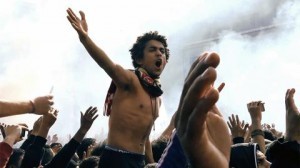
Al Jazeera- Ultras
Because of the power that the Ultras had in creating political change, it is argued that the negligence in the Port Said massacre was, in fact, a revenge act, and that the police purposefully let the bloodshed continue as punishment to the Al-Ahly ultras for the events of the year before.
Even now, the present bloodshed at hand cannot be disconnected from political issues. BBC reports that “the president of Zamalek, Mortada Mansour, said in an interview with a private TV station that police had not opened fire on the club’s fans, and that the violence was ‘orchestrated’ to undermine the upcoming parliamentary elections”. Mansour is a strict supporter of the current government and it’s leader/ military chief Abdel Fattah el-Sisi. Furthermore, the government’s prosecutor has already ordered the arrest of the leaders of the White Knights.
Clearly, this is a developing conflict that is far from simple or close to being resolved. The football world of Egypt is irrevocably intertwined with the political arena. With all the recurring bloodshed, it is clear that a temporary stall in Egyptian soccer won’t solve the current underlying issues.
Una Comparación Entre los Escudos de los Clubes de Futbol
Cuando miras un partido de futbol, usualmente se concentras en el juego, no los logos de los equipos que juegan. Pero los escudos de los clubes son muy importantes: los logos sirven como representaciones de las relaciones de los clubes con sus ciudades de origen. Es interesante de contrastar los escudos de los clubes de España y de Inglaterra. En España, los escudos tienen implicaciones políticas. Por ejemplo, el logo de Barcelona tiene elementos representativos de Catalunya, y se utiliza para promocionar el movimiento de libertad en Catalunya. Los escudos de los clubes de Inglaterra son más conectados a la historia de los ciudades. El lolo de Manchester United tiene una barca para celebrar la destreza comercial de Manchester y el canal de navegación. Desde logotipos son tan importantes, aquí están las historias de las crestas de cuatro de los clubes de fútbol más conocidos y más importantes en el mundo.
La cimera inicial de FC Barcelona era formado de diamante en cuatros. Tenía la carona de Aragón, el murciélago de King James, y dos ramas, una de laurel y una de palma. Era el escudo de la cuidad de Barcelona, y por eso, expresaba la vinculación de club con la ciudad que le vio nacer.
El club tuvo un concurso en 1910 de los miembros para diseñar un nuevo cimera, y Carles Comamala, un jugador, ganó. El escudo que Comamala diseñó era muy similar de la cimera hoy en día, con unas modificaciones. El primero diseño tenía la Cruz de San Jorge en la esquina superior izquierda y la bandera catalán en la esquina superior derecho. Los dos eran elementos representativos de Barcelona y Catalunya. Los colores del equipo y un futbol eran en la parte interior. En el centro de escudo en una franja aparecía las iniciales de club, FCB. El escudo reflejaba la dimensión deportiva del club y la vinculación del club a la cuidad y el país.
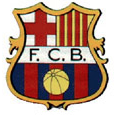
Durante la dictadura de Franco, las siglas FCB fueron sustituidas por CFB. Franco quería que el nombre de club era totalmente en español, y por eso “Football Club” se cambió a “Club de Futbol” o CF. También las cuatro barras se limitaron a dos para excluir la bandera catalana.
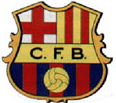
En 1949, se recuperaron las cuatros barras, por el quincuagésimo aniversario del club. Las siglas originales no se recuperaron hasta finales de 1974, cuando volvió al contenido original de 1910. En 2002, el diseñador Claret Serrahim, que se decantó por unas líneas más estilizadas, eliminó los puntos que separaban las iniciales del club, abrevió el nombre, y redujo el número de puntas para modernizar el escudo. Las líneas más sencillas se hacen más fácil la reproducción del logo. Por eso, el escudo hoy en día es simplificado.
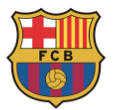
El 6 de marzo 1902, un grupo de aficionados fundió el Madrid Futbol Club. El primer escudo era una mezcla de los tres iniciales del club (M.F.C). Los colores son azul por el escudo y blanco por los camisetas. Pero para jugar en la ciudad de Madrid, el club se necesitaba utilizar el escudo de Ayuntamiento de Madrid. Los escudos circulares se asocian con la izquierda del Madrid, pero en realidad es el escudo de la ciudad de Madrid.

En 1908, el club rediseñó el escudo. Adoptaban una forma más estilizada, encuadradas en un circulo. Seguirá siendo utilizado hasta nuestros día. El 29 junio de 1920, Rey Alfonso XII concedió el título “Real” por documento público. Entonces eran “Real Madrid Foot Ball Club”. Por eso, se adoptó la corono borbónica.

Con la llegada de la República, el escudo perdió la corona porque la Republica se prohibía los símbolos de la monarquía Se le añadió la banda morada de la región de Castilla. . Es interesante que la banda de la región de Castilla estaba incluido en el logo de Real Madrid, pero la bandera Catalunya estaba eliminado en el escudo de Barcelona.

Desde 1941, tras la Guerra Civil, el escudo otra vez estaba coronado, tras la vuelta formal de la monarquía durante el régimen. Se modificaron los colores, y el dorado era el predominante. Se mantendrá hasta principios de los noventa. El escudo actual es más estilizado, con una banda más estrecha, la letra “m” más grande y el grosor de las letras más grande.
El primero escudo tenía un imagen de la “Chelsea Pensionista”, pero nunca llevaba el escudo, se utilizó solamente para programas. En 1952, Ted Drake quería crear una nueva imagen por el club relacionaba con la nueva apodo del club, los “azules”. El mas famoso escudo del club, antes de Ted Drake, estaba inspirado por el capa cívica de armas de la ciudad metropolitana de Chelsea. El león era derivado de las armas del conde Cadogan, el presidente del club y vizconde de Chelsea. El bastón es del abad de Westminster. Las rosas representaba al Inglaterra, y los balones de futbol representan el juego. Chelsea no portaba el escudo hasta que 1960. Se utilizaron versiones simplificados durante las sesenta y setenta.

En 1986, Chelsea se adoptaba un nuevo escudo para promocionar el club. Se utilizaba las letras y el león, y se han usado muchos colores para el diseño siendo los mismos.
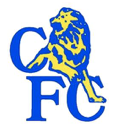
Pero los aficionados demandaba el escudo original para el centenario. El escudo hoy en día era de noviembre 2004 que se basa en el diseño de los años cincuenta. Peter Kenyon, el director ejecutivo de Chelsea dijo, “A medida que nos acercamos a nuestro año del centenario, y el club se embarca en una era nueva y muy emocionante, es apropiado que tenemos una nueva identidad que refleja nuestra tradición y nos puede representar para los próximos 100 años”.
El escudo de Manchester United se basaba en el escudo de armas del Consejo de la Ciudad de Manchester. Estaba bordado en las camisas primero en el final de la Copa FA en 1963. El barco en la cresta era una referencia a la destreza comercial de Manchester y el canal de navegación. El globo representaba el poder mundial de comercio de la ciudad, y las abejas representan la industria y la empresa, porque Manchester era la cuna de la revolución industrial. Había un antílope que portaba una cadena de oro, y se refería a obras de ingeniería de la cuidad. También había un león que portaba una carona castillo porque la ciudad creció alrededor del asentamiento romano del castillo de campo. Los dos se portaban la rosa roja que es el símbolo oficial de Lancashire. “Consilio et Labore”, la consiga en el fondo, se traduce como “La sabiduría y esfuerzo”
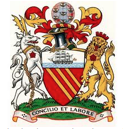
Durante los años sesentas, la insignia tomaba el escudo y la nave de la capa Ayuntamiento de Manchester de armas. El logo nuevo fue diseñado por el nuevo estilo de juego que Matt Busby llevó al Manchester United durante los años cuarenta. El símbolo del diablo en la insignia Manchester United reemplazar las tres rayas amarillas en los años setentas. Era el apodo del club hasta que Matt Busby adoptó para el club para atemorizar a sus oponentes. El consiguió del nombre era los Salford City Reds o Les Diables Rouges. 1972-73 era la primera temporada en que el logotipo de Manchester United era una característica permanente de la camiseta de futbol del club.
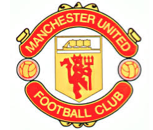
En 1998, la insignia perdió el “Club de Futbol” de la bandera y lo sustituyó por “Estados”. Fue creado en un esfuerzo por convertir el Manchester United en una marca.
Por lo general, los logos de los equipos de futbol tiene significado grande para los aficionados y la ciudad del club. Es muy interesante de descubrir los origines de los escudos. Sugiero que utilizas el red para aprender sobre tú club favorito, porque puede abre los ojos a la nueva e importante información sobre el club que creías saber.
Le Premiership – Une ligue n’est plus du coté du peuple
Récemment, quelques fans de l’équipe Liverpool FC ont apporté un signe à un match qui a dit, « supporters not customers » (supporteurs pas clients), un semaine plus tard des autres fans ont apporté des signes qui a dit, « 1990 – £4, 2000 – £24, 2010 – £43, 2020 – ???. » Il est clair que maintenant le Premier League en Angleterre est en face d’un grand défi. Basé sur le coût des billets aux matchs, en vingt ans les prix des billets ont multiplié dix fois ! Clairement, les fans autour de l’Angleterre sont mises en colères par l’augmentation des prix. Donc, pourquoi est-ce que ces prix ont augmenté comme ca, et comment peut le Premiership garde ses racines d’une ligue pour les peuples ?
Tout d’abord, c’est un fait commun que le cœur du foot existe avec le soutien des fans. Les grandes équipes mondiales ne seront rien sans l’aide de leurs fans fidèles. Ainsi, c’est la responsabilité du propriétaire, l’entraineur, n’importe qui est en charge des finances, il doit garder l’accessibilité aux matchs pour les fans. Ces faits sont clairs, mais il faut qu’on demande, comment est-ce que ces chefs de finance peuvent mépriser ce fait comme simple. C’est la règle d’or des affaires, ‘le client est toujours premier’. Donc, pourquoi est-ce que ces clubs doivent augmenter leurs prix ? Je comprends que le foot est une entreprise, mais il y a beaucoup des façons pour améliorer les profites. Pour exemple, récemment Sky et BEiN ont acheté les droits pour diffuser tous les matchs du Premiership pour £5.16 Milliard ! Ce chiffre signifie que les droits de chaque match coûtent £10 Million ! Avec ce nouveau revenue pour les clubs et les centaines d’autres manières pour collecter des fonds.
Avec chers billets et chers émissions sur la télévision le foot devient plus et plus inaccessible au peuple. Une fois une ligue qui a s’enorgueilli d’être abordable et pour les fans, mais actuellement un entonnoir d’argent. Il faut que le Premiership baisse les prix des billets. Comme Gary Lineker, un analyste du foot suggère, quand les fonds collecté du TV s’élèvent, les prix des billets doivent baisser. En plus, on peut voir des statistiques qui montre que la coûte des billets n’a pas une corrélation avec la réalisation de l’équipe. Pour exemple, Man City, l’équipe qui a gagné le Premiership l’année fois et aussi l’équipe avec des tonnes d’argent, cette équipe a les plus bons marchés billets pour la saison. En plus, Newcastle, une équipe qui est toujours supérieur à la moyenne a les moins chers billets pour les matchs.
Alors, s’il n’y a pas une corrélation avec le succès d’une équipe et les coûtes des billets, il faut que les équipes baissent leurs prix. Je sais que quelques équipes n’ont pas l’espace financièrement, mais il faut que le plupart des équipes en le Premiership recommence à se concentrer sur les fans et les peuples, n’est plus les profites. Comme les manifestants fans les rues de Liverpool ont dit, le foot n’est rien sans le soutien. Un mouvement commence en l’Europe où les peuples ont commencé à réagir que les clubs ne sont pas complètement concentrés sur les fans. Un sondage a demandé, « Est-ce que le foot se détruit soi-même ? La réponse ? 86% des gens ont dit, oui, le foot se détruit soi-même, ca commence avec les finances. Alors, les chefs des équipes je vous implore pour le salut de vos âmes, changez-vous vos tactiques, et récréé une ligue qui met les fans tout d’abord.
FA Foreign Policy
Over the last decade we have witnessed the English Premier League turn into one of the major hubs for international football stars. It has increased the inter-club competition, evening up the playing field, causing the league to become arguably the best league in the World. However, in early September, Greg Dyke, the FA chairman, released plans to tighten legislations on foreign players entering the Premier League. The intention would be to re-discover the British heritage and develop a strong core within clubs. Such a regulation would also help to improve the National team and maybe relive the 1966 World Cup triumphs. However, are such policies already beginning to hinder the EPL and starting to strengthen other European confederations?
In lieu of the the January transfer window, Arsene Wenger spoke out about his struggles in signing Gabriel Paulista. The £11.3 million deal was put on the brink of falling through when a work permit battle surfaced. This isn’t the first time Arsene Wenger has run into problems with immigration authorities, for his stars. In late July Alexis Sanchez missed Arsenals’ preseason training camp, in Austria, due to Visa problems. Joel Campbell has had constant struggles with obtaining a work permit and despite Arsenal owning him, he has had to be repeatedly loaned out to other European clubs. This is merely the surface of the issue. Many clubs cherish and pride themselves on their complex international scout networks and youth teams but run into even greater difficulties with acquiring the raw talent.
For a player to establish an initial application they must have played for his country in at least 75% of its competitive A team matches of which he was available for selection, during the two years preceding the date of the application. Secondly, the player’s country must be at or above 70th place in the official FIFA world rankings. This immediately makes it possible for only elite players to make the cut and puts youngsters at near impossible odds. Surely it would be more beneficial for youth players to playing alongside the very best as then their game will improve quicker. Professionalism will arise faster, their traits will infest each other, the do’s and don’ts will be learnt and they will feed of one-another’s energy. Players dream of playing under elite managers and legends as they know it’ll elevate them to that next level. So surely there are better methods of improving the core then by erasing the competition?
Other policies could be set up that provide clubs with benefits or incentives to produce “home grown players”. For example, in 2010 the “Home Grown” player quota was implemented allowing a minimum of 8 home grown players in any 25 man squad. This policy has had only scratched the surface and hasn’t really made an impact as teams can easily bypass this ruling. It’s evident that the emphasis should be put into the lower ages such as elementary and middle school kids. After school programmes could be set up by the FA to facilitate these activities or weekend away courses implemented. The underlying issue isn’t the league but its root causes are the foundations or as José Mourinho prescribed; “In England you teach your kids how to win. In Portugal and Spain they teach their kids how to play”.
February 10, 2015
Spieler und soziale Medien
Soziale Medien haben viele Vorteile für Fußball (und andere Sportarten!). Fußballfans können ihre Lieblingsmannschaften und Spieler mithalten und Mannschaften können ihre Fangemeinde erweitern. Also sind soziale Medien eine Möglichkeit für Mannschaften, mit ihre Fans zu kommunizieren. Das ist eine „Win-win-Situation?“ richtig?
Vielleicht nicht. Ein Artikel von der Welt, die „Bayern-Profi entschuldigt sich für Stringtanga-Bild“ heißt, zeigt, wie soziale Medien negative Aufmerksamkeit auf Fußballspieler und Mannschaften bringen können. Soziale Medien ermöglichen einen Einblick ins Privatleben der Spieler. Fotos, Videos, alles – die Welt kann sehen.
Obwohl Spieler denken, dass Fotos und Videos unverfänglich und lustig sind, vergessen sie, dass das Internet dauerhaft ist. Spieler müssen selbst sich absichern – in und aus dem Internet.
Zitate
February 9, 2015
Penalty kicks in determining championship winner………..African Cup of Nations
The just concluded African Cup of Nations Championship game was decided on penalties after the game ended in a barren draw through the regular time and two 15-minutes overtimes. In this game, 17 goals were scored, all of them from the penalty spot, 12 yards from the goalkeeper. Each of the 22 players on the pitch at the end of the second overtime took a penalty kick.
In soccer, penalty kick is a free kick taken from 12 yards (around 12 meters) away from the goalkeeper. It is a direct faceoff between the goalkeeper and the penalty taker. The goalkeeper is not allowed to move from the goal line. While penalty kicks are used as a punishment for a ‘bad play’ in the goal area, they are mainly used as a tiebreaker when games end in either a barren draw or the teams score equal number of goals. Penalties are not applied in all games that end in a draw, they are mainly used in championship games where a winner has to be decided at the end of the game. They have been used to decide the outcome of soccer matches in world’s biggest stage especially in the World Cup and the Champions League when two tactically disciplined teams are unable to find the back of each other’s net.
In this article, Larry Mahoney argues that nobody seems to like penalty kicks but there is no another option of breaking a tie in a soccer game. In my opinion, a soccer match is meant to be played and won from the field not at the penalty spot. At the penalty spot, everybody has an equal chance of winning the game, regardless of whether they are the best team or not. It only takes a small mistake and the game is lost. Putting a player on the penalty spot gives them a lot of pressure and a small mistake can make them a victim and even ruin their lives. In the 2010, Asamoah Gyan was Ghana’s best player through the tournament. He was loved and cherished by soccer fans in Ghana. Then he missed the penalty kick that would have made Ghana the first African country ever to play in a World Cup semifinal. He went from being and idol to being the most hated person in Ghana within an instant. It took the intervention of the Ghanian president to calm the soccer fans in the country who were threatening to do all sort of things to the man who had been a national hero just a few days ago after scoring the winning goal against US that booked Ghana a place in the World Cup quarter finals.
The African Cup of Nations final was not very exciting over its regular time. Both teams were not able to establish a flow through the game and they struggled to consistently put together a good attacking move or something exciting. This can be attributed to both teams seemingly being more defensive minded or the pressure that comes with the enormity of the game. However, the penalty kicks turned out to the most entertaining part of the match. From Ivory Coast missing its first two to their goal keeper seemingly collapsing on noticing that he was the one to take the deciding penalty and receiving a yellow card just before kicking the winning shot. The whole shootout was entertaining as evident from the video below, but I still think penalty kicks should not be used to decide a championship game.
Futbol femenina: Un punto de vista estadístico
Me pareció muy interesante la presentación de Carla Overbeck y Cindy Parlow sobre sus experiencias como miembros del equipo nacional de futbol que compitió en la Copa Mundial de 1999 y otras grandes competiciones internacionales. Aunque había visto las películas documentales como “Dare to Dream” antes de su presentación y reconocí el esfuerzo intenso que necesitaron hacer los jugadores para desarrollar una relación substantiva con sus fanáticos, me sorprendió la falta de beneficios y apoyo financiero que enfrentaron ambas jugadoras consistentemente durante su experiencia. Por eso, decidí a buscar más información que detallada la experiencia de los jugadores en el equipo nacional de mujeres hoy en día.
Encontré un artículo que sugiere que el problema de malos beneficios para las jugadoras profesionales en los EE.UU. (que son las mismas personas que probablemente van a contribuir al equipo nacional en los próximos Juegos Olímpicos y Copa Mundial) todavía existe, y que no hay mucha diferencia entre las condiciones ahora y las del pasado. El título del artículo, que se puede leer en la sección de deportes en fivethirtyeight.com, es “Low Pay Limits Player Experience in National Woemen’s Soccer League.” La autora, Allison McCann, destaca un realidad severa: para tener éxito en las competición mas difíciles (especialmente en la escena internacional), es necesario construir una liga en los EE.UU. que puede atraer a las jugadoras mas fuertes y expertos, incluyendo aquellas que NO serán seleccionados finalmente para el equipo de la Copa Mundial. El problema es que los clubs de futbol profesional para mujeres todavía no tienen una cantidad adecuado de recursos financieros para mantener una lista. A su vez, esta dinámica no les permite a los administradores y entrenadores desarrollar plenamente jugadores individuales o química del equipo. Como dijeron Carla y Cindy, no es posible para los miembros del equipo vivir con un sueldo que es, en muchos casos, menos de 15,000 dólares cada año. Y por eso, no hay una oportunidad para adquirir experiencia adecuada.
Lo que me fascinó de este articulo era su enfoque en las estadísticas que explican el impacto de la cuestión de sueldo, y la exigencia implícita de que las jugadoras mantienen otro trabajo a tiempo completo mientras trabajan como futbolistas profesionales. Las conclusiones de la grafica, que muestra el numero de años que tiene las jugadoras fuera de la universidad y el numero de años que juegan en el equipo nacional, ilustran el problema fundamental de los programas de futbol para mujeres en los EEUU—en pocas palabras, el hecho de que la infraestructura actual y la falta de una verdadera “liga” con sueldos legítimos les impide a los jugadores adquirir experiencia que se traduciría en el éxito en una competición internacional. De acuerdo a la gráfica, las jugadoras elegibles (que son parte de la NWSL) han estado fuera de la universidad por dos años en promedio, y todas faltan experiencia jugando en el equipo nacional. Esto demuestra la peligrosa dinámica que domina futbol para mujer en los EE.UU.—los sueldos bajos y la falta de beneficios que mencionaron Carla y Cindy son factores que expulsan las mujeres fuera de la liga antes de que puedan desarrollar plenamente en las mejoras jugadoras que pueden ser.
Laurent Dubois's Blog
- Laurent Dubois's profile
- 44 followers


